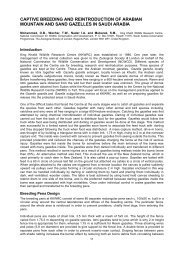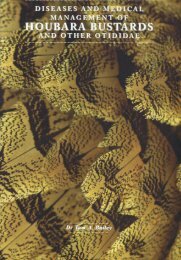His Highness Sheikh Zayed bin Sultan Al Nahyan - Wildlife Middle ...
His Highness Sheikh Zayed bin Sultan Al Nahyan - Wildlife Middle ...
His Highness Sheikh Zayed bin Sultan Al Nahyan - Wildlife Middle ...
Create successful ePaper yourself
Turn your PDF publications into a flip-book with our unique Google optimized e-Paper software.
Treatment of Lead Poisoning in Hunting Falcons<br />
Dr Laco Molnar, The <strong>Al</strong> Warsan Falcon Hospital of H.H.<br />
Sh. <strong>Sultan</strong> Bin <strong>Zayed</strong> <strong>Al</strong> <strong>Nahyan</strong>, Abu Dhabi, P.O. Box<br />
77338, United Arab Emirates. molnar@emirates.net.ae<br />
Summary<br />
An article summarising clinical experience with<br />
treating lead poisoning in hunting falcons used in <strong>Middle</strong><br />
East falconry. This condition was an important<br />
phenomenon in the past, when birds killed with a shot gun<br />
were the main source of falcon food (Molnar, 2001).<br />
Occasional cases still occur, but the commercial availability<br />
of processed frozen falcon food has markedly reduced the<br />
incidence of this condition. Lead poisoning is still frequent<br />
in wild eagles and scavenging raptors (Kramer, 1997; Saito,<br />
1997). Between 1999 and 2000 eighty-five falcons,<br />
suspected to have been exposed to shotgun lead pellets,<br />
were tested for lead poisoning. Tested falcons included<br />
saker falcons (Falco cherrug), peregrine falcons<br />
(F.peregrinus), gyr falcons (F.rusticolus) and their captive<br />
bred hybrids. Positive cases were confirmed by<br />
1) the presence of radiodense heavy metal particles<br />
in gastro-intestinal tract.<br />
2) elevated whole blood lead levels.<br />
3) inhibited delta-aminolevulinic acid dehydratase<br />
(ALAD) activity.<br />
Thirty-two percent of all tested falcons were testnegative<br />
for lead poisoning. Fifty-two percent were subclinical<br />
cases with elevated whole blood lead level or<br />
decreased ALAD activity. Sixteen percent of the falcons had<br />
severe symptoms of lead poisoning. Radiographs from only<br />
seven falcons (8.5%) showed heavy metal particles in<br />
ventriculus. Successful treatment was achieved with a<br />
repeated (2-3 times) regime of 5% Ca EDTA<br />
(Calciumedetate), ANIMALCARE (35 mg/kg TID or 50<br />
mg/kg BID) for 5 days. In very severe cases when ALAD<br />
activity was 100% inhibited and blood lead levels exceeded<br />
100 ml/l, 80-100 mg/kg EDTA i.v. with 20 ml Lactated<br />
Ringers solution markedly reduced the blood Pb levels and<br />
the clinical symptoms. The falcons fully recovered and<br />
subsequently performed very well as a falconry birds.<br />
Toxic effect of lead<br />
Lead is not a biogenic element. It is considered to<br />
be hemotoxic, neurotoxic, nephrotoxic and imunotoxic. In<br />
organisms lead inhibits different enzymes by its <strong>bin</strong>ding<br />
affinity to sulfhydryl (SH-) groups. From the clinical point<br />
of view the main diagnostic value is its haematotoxic<br />
abilities (Scheuhammer, 1987). Lead causes microcytic<br />
hypochromic anaemia in chronically exposured cases. The<br />
following enzymes incorporated to the cascade of<br />
haemoglo<strong>bin</strong> synthesis are inhibited (Pagliuca et al., 1990):<br />
d-ALAD (delta-aminolevulinic acid dehydratase),<br />
ferochelatase,<br />
uroporfyrin and protoporfyrindekarboxylase,<br />
pyrimidin-5-nukleotidase.<br />
As an effect of lead, the activity of d-ALAD is<br />
decreased and its substrate, ALA (aminolevulic acid),<br />
concentration is increased in the blood. The enzyme<br />
ferochelatase is also inhibited. Ferochelatase is responsible<br />
for incorporation of iron molecule (Fe3+ ) into porphyrin<br />
cycle. As result of this inhibition in the acute cases the<br />
concentration of Fe3+ and also free porfyrins increase in the<br />
blood.<br />
Materials and methods<br />
Tested falcons were presented for routine clinical<br />
examination with different complaints. Most often the<br />
owner noticed decreased performance, muscle weakness,<br />
reduced appetite or constant weight loss even during excess<br />
feeding. In severe cases greenish discoloration of urine,<br />
crop stasis and seizures were presented. The CNS<br />
symptoms manifested usually after short-term exercise for<br />
only 0.5-2 minutes. The most typical symptom of acute<br />
lead poisoning with markedly increased blood lead levels<br />
was dysvocalisation. The falcons during exhalation<br />
vocalised a “ka-ka-ka-ka” –like voice. Endoscopic<br />
examination of the trachea revealed a narrowed lumen of<br />
the syrinx due to decreased tension of the external tympanic<br />
membrane. In cases where radiologic examination showed<br />
metallic, radiodense particles in the ventriculus the falcon<br />
was anaesthetised with isofurane and the particles were<br />
flushed out using a 5mm in diameter and 30 cm long gastric<br />
tube and 60 ml warm water. From all falcons with these<br />
16




